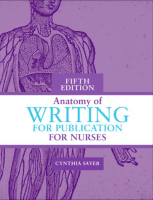Do you think you deserve clinical advancement? Are you having trouble writing a narrative to prove it? If so, you’re not alone. When 80 applicants at the University of Connecticut Health Center (UCHC) were asked what intimidates them most about the advancement process, they all said writing.
Advancement programs require a written reflection on a professional experience to document clinical excellence. Kathleen Heinrich, this article’s coauthor, piloted the first workshop for UCHC applicants with input from coauthor Cheryl Tafas in 2008. We then asked Christine Jackson, a successful workshop graduate (and third coauthor), to join us.
This article shares 12 steps for success adapted from our workshop “Write a clinical situation narrative that affirms your excellence.” After you read Christine’s story, Kathleen’s writing tips, and Cheryl’s insights into clinical advancement, you’ll be ready to complete your own narrative.
Get in a creative mood
Writing a clinical situation narrative is a creative act. The steps below help prepare you to be creative.
Step 1: Take a time out
Christine’s story: Finding time to focus on writing seemed impossible for me—a busy wife, mother, and assistant nurse manager. To quiet my thoughts, I gently asked my family to vacate the premises. Then I shut off my cell phone and settled into a comfortable chair by the fire.
Kathleen’s TIP – Before starting a creative task such as narrative writing, take a time out. Whether it’s three deep breaths or walking the dog, keep it simple, make it quick, and do it every time.
Step 2: Quiet your inner critic
Christine’s story: During my time out, fears about going for advancement reared their ugly heads—lack of time, lack of confidence in my writing ability, being judged by others, and sounding like I was blowing my own horn.
Kathleen’s TIP – Whenever your inner critic appears, welcome him as an old friend and address his fears by taking these 12 steps.
Step 3: Put your “special something” into words
Christine’s story: Once I quieted my inner critic, I was able to reflect on my unique qualities. Recalling what others have said about my practice helped me identify a common thread. Managers have described me as extraordinarily compassionate and highly competent. Coworkers have said I am very approachable and someone you’d want with you when patients crash. This combination is my “special something.”
Kathleen’s TIP – Make your “special something” search a treasure hunt. Note which phrases are repeated in patients’ thank-you notes and your yearly reviews. Ask colleagues to explain what makes your nursing care stand out.
Search for your clinical-situation story
A story describes an experience; a narrative involves a reflective process that assists in describing the story and interpreting the experience. The next three steps help you sift through your nursing experiences to find a story for your narrative.
Step 4: Become a reflective practitioner
Christine’s story: Until I tried to find a clinical situation for my narrative, I didn’t realize the difference between caring for patients and telling a story about how I care for them. Here’s what I mean: When we were asked to bring a story to share with a workshop partner, I had one in mind. So I was surprised when an entirely different story popped out spontaneously. Speaking this clinical situation aloud helped me figure out which story to tell.
Kathleen’s TIP – Ask yourself, “What clinical situation called out my best as a nurse?” If you’re unsure, test-drive several by sharing them with a colleague.
Step 5: Find a story that showcases your clinical excellence
Christine’s story: Weaving the details of my clinical situation into a respectable narrative was daunting. I knew I’d made a difference for the fractured family whose story I chose. Could I turn this story into a narrative that illuminated my clinical practice? I knew the answer was “yes” when I realized this clinical situation required both technical skill and psychosocial expertise.
Cheryl’s TIP – Choose a story that communicates your “special something.” Go beyond reviewing the interventions that made a difference. Turn your story into a narrative by interpreting what happened and explaining how you were changed.
Step 6: Choose a story that best illustrates nursing model concepts
Christine’s story: When reading Synergy for Clinical Excellence: The AACN Synergy Model for Patient Care, I came across a phrase that captured my “special something”: holistic, compassionate care. When my story, in the language of this model, meshed my specific nurse competencies with this patient’s and his family’s specific characteristics and needs, I knew it was a keeper.
Cheryl’s TIP – Choose a story that illustrates the broadest range of concepts in your organization’s model. Integrate concepts and language from this model into your story.
Plan the narrative writing process
Writing a narrative takes planning. The next three steps help you plan your writing process.
Step 7: Describe your narrative in one sentence
Christine’s story: Summing up my narrative in a single sentence was the hardest step. After revisions, mine read: “This clinical-situation narrative makes the case for my promotion to Clinical Nurse III level by describing an encounter with a client and family that demonstrates how my clinical competence is interwoven with holistic, compassionate care to achieve an optimal outcome for the patient-family system.”
Kathleen’s TIP – Use this formula to draft your single sentence: “This clinical-situation narrative makes the case for my advancement to…”—plus the level you’re applying for, plus an overview of the clinical situation, plus your special something, plus your desired outcome.
Step 8: Get familiar with expectations for clinical-situation narratives
Christine’s story: To ensure my narrative met my organization’s expectations, I read and reread the synergy model book, accessed resources from our hospital’s website (including relevant articles), and attended advancement workshops.
Cheryl’s TIP – Clarify your organization’s criteria for clinical-situation narratives and access available resources. Review narrative samples considered to be exemplars of excellence.
Step 9: Set a timeline
Christine’s story: Being goal-oriented, I work well with deadlines. My timeline, revised weekly, included such manageable tasks as writing a rough draft, asking people to join my support team, and revising.
Kathleen’s TIP – Start your timeline with the advancement-packet due date. Timelines keep you on task and your narrative-writing project on target.
Work smart
The next three steps will help you work efficiently.
Step 10: Chunk out a rough draft into mini-writing sessions
Christine’s story: I wrote my narrative in bits and snippets. With my single sentence as a starting point, I let my story flow onto the paper without worrying about spelling or editing. This free-write became the rough draft I turned into an outline with five “chunks.” The chunks became narrative sections with these headings: Rationale for advancement; Clinical background and current practice setting; Encounter with the patient and his family; Follow-up and outcomes; and Conclusion. Then I revised each section as time allowed.
Kathleen’s TIP – Chunk your draft into 10- or 15-minute writing sessions.
Step 11: Create a support team
Christine’s story: When Cheryl agreed to review my narrative, she became my formal support colleague. My family became my informal support team.
Cheryl’s TIP – Include colleagues who know your practice and are familiar with narrative writing and the nursing model in your support team.
Step 12: Revise drafts into a final narrative
Christine’s story: Revising was a back-and-forth process. After reading a draft to my family, I e-mailed the revision to Cheryl. She returned it with such suggestions as “Give yourself credit for caring enough to follow up with this patient after discharge” and “Describe how you translated this story into a teachable moment for your staff.”
Cheryl’s TIP – Get help to clarify details, make interpretations, and apply model concepts. Revise until your narrative conveys the story you want to tell and meets organizational criteria.
Combined with Kathleen’s writing tips and Cheryl’s advancement tips, the 12 steps above gave Christine the self-confidence, skills, and support she needed to craft her clinical-situation narrative. If you follow these guidelines, you’ll be more confident about writing an advancement-winning narrative.
Visit www.AmericanNurseToday.com for a complete list of references.
Kathleen T. Heinrich is a principal at KTH Consulting in Guilford, Connecticut. Cheryl Tafas is an education development specialist at the University of Connecticut Health Center in Farmington. Christine Jackson is a nurse manager at the Farmington Surgery Center at the University of Connecticut Health Center in Farmington.

















